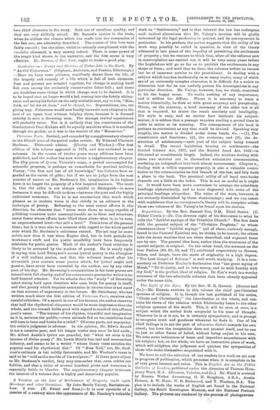work on "Settlements," and in that interval the law has
undergone such radical alterations that Mr. Vaizey's treatise will be gladly welcomed by the legal profession in general, and by conveyancers in particular. In his preface, the author suggests that the utility of his work may possibly be called in question, in view of the theory advanced in late years of the impolicy of permitting the settlement of property ; but we venture to think that, after all the reforms now in contemplation are carried out, it will be very many years before the Legislature will go so far as to prohibit the settlements in any shape or form; and until that be done, the volumes before us cannot but be of immense service to the practitioner. In dealing with a subject which touches incidentally on so many topics, many of which are of an extremely complex character, it is difficult for a writer to determine how far he can usefully pursue his investigations in any particular direction. Mr. Vaizey, however, has, we think, contrived to hit the happy mean. He omits nothing of any importance, and is seldom too diffuse. Where it is necessary to trace a matter historically, he does so with great accuracy and perspicuity. Where, on the contrary, a brief summary of the older law is all that is required, he states the result concisely and intelligibly. His style is easy, and no matter how intricate his subject- matter, it is seldom that a passage requires reading a second time in order to arrive at its meaning. The arrangement of the book is perhaps as convenient as any that could be devised. Speaking very roughly, the matter is divided under three heads, viz. :—(1), The constitution and functions; (2), the contents; and (3), the de- struction of settlements,—each part of the subject being treated in detail. The recent legislation bearing on settlements—the Settled Estates Act, 1877, and the Settled Land Ad, 1882—is discussed at considerable length. Indeed, the sections dealing with these two statutes are in themselves exhaustive commentaries, rendering an independent text-book almost unnecessary. Chapter x., dealing with a wife's separate property, is also a valuable contri- bution to the commentaries on this branch of the law, and fitly finds a place in the book. The practical utility of all legal text-books depends not a little on the index. This is not as useful as it might be. It would have been more convenient to arrange the subsidiary headings alphabetically, and to have dispensed with some of the principal headings altogether. The value of the work, however, is not seriously diminished by these shortcomings ; and we can assert with confidence that no conveyancer's library will be complete unless these two volumes of Mr. Vaizey's be found upon his shelves.


















































 Previous page
Previous page